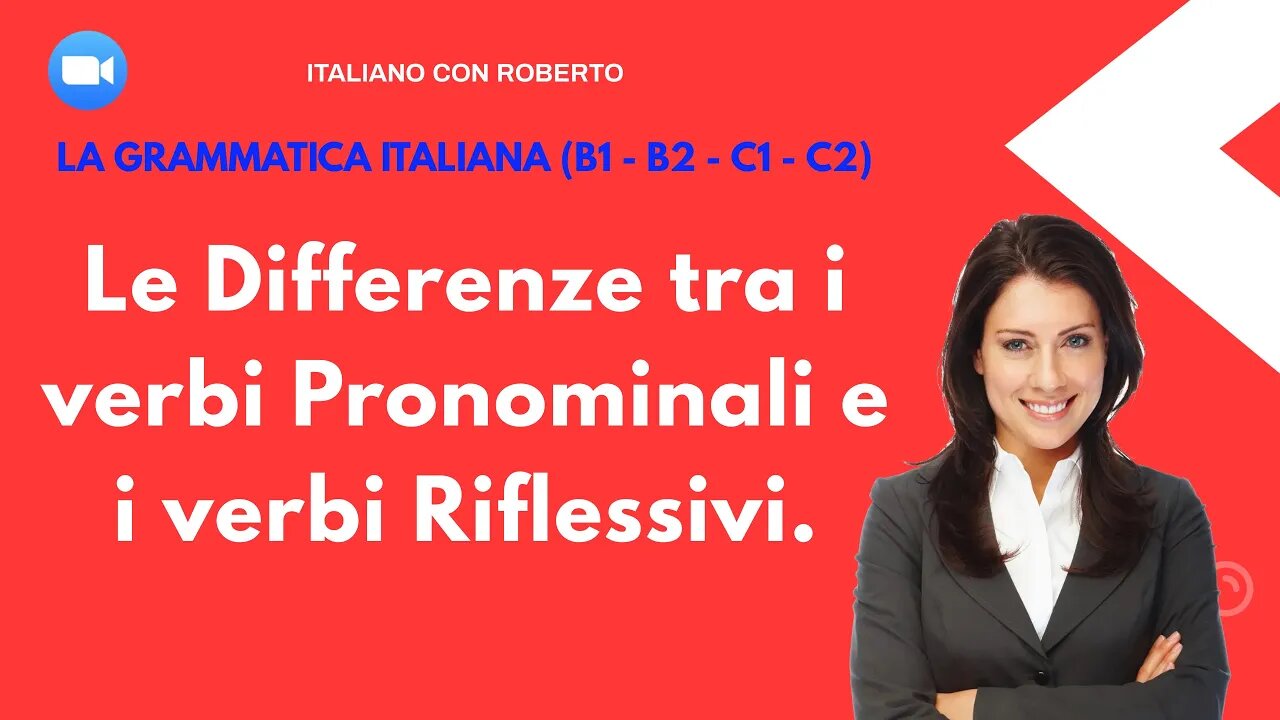Premium Only Content

"Did you know that you use pronominal and reflexive verbs incorrectly? Find out how to avoid it.
#RobertoBorzellinoLinguaitalianaperstranieri.
The differences between reflexive verbs and pronominal verbs.
Reflexive verbs and pronominal verbs are often confused and used interchangeably, but there are actually some important differences between the two.
First, reflexive verbs are a category of verbs that require the use of a reflexive pronoun to indicate that the action is performed by the subject on itself.
For example, "I wash myself" means that I am washing myself.
Reflexive verbs are formed by adding the reflexive pronoun to the base verb.
For example, "to wash" becomes "to wash oneself" when used as a reflexive verb.
On the other hand, pronominal verbs are a category of verbs that require the use of a reflexive pronoun but have a different meaning from non-pronominal verbs.
For example, the verb "to go" means "to move from one place to another" when used without the reflexive pronoun, but means "to agree" when used with the reflexive pronoun "to go."
In this case, "to leave" means "to go away" or "to go away from someone or something."
In addition, pronominal verbs can be used in many verb forms, such as the infinitive, gerund, past participle, etc., while reflexive verbs can only be used in certain verb forms, such as the present tense, the near past, the imperfect, etc.
Another difference between reflexive verbs and pronominal verbs is that reflexive verbs require the reflexive pronoun to indicate that the action is performed by the subject on itself, while pronominal verbs require the reflexive pronoun to indicate a change of state or passive form.
For example, "to dress" means "to put on clothes" while "to be dressed" means "to have clothes on."
In summary, reflexive verbs require the use of the reflexive pronoun to indicate that the action is performed by the subject on itself, while pronominal verbs require the reflexive pronoun to indicate a change of state or passive form.
In addition, pronominal verbs can have different meanings from non-pronominal verbs and can be used in many different verb forms.
Knowing the difference between the two types of verbs can help you avoid mistakes and misunderstandings when communicating in Italian.
The videos in this channel are dedicated to the Italian language and culture. The main topics will be grammar lessons, exercises, dialogues from everyday life, history, geography, fashion, cooking and much more.
My books on Amazon. Level A1/A2 I recommend the following textbooks:
For students of Russian language: https://www.amazon.it/dp/1521583730
For English language students: https://www.amazon.it/dp/1657435474
For students of German language: https://www.amazon.it/dp/B095GJ5WS5
For Chinese language students: https://www.amazon.it/dp/B08YQQWT32
For students of the Brazilian language: https://www.amazon.it/dp/B0B5KVJNJ9
For students at B1/B2/C1/C2 level, I recommend my novels: dictionary, exercises and solutions.
https://www.amazon.it/dp/B08DSVJZNB (Dead End Road)
https://www.amazon.it/dp/B08DSSCRLZ (The Red Jasper)
https://www.amazon.it/dp/B08TW5FLVK (The Curse of the Isle of Cora)
https://www.amazon.it/dp/B095GRWSBR (Militaria)
-
 2:30:50
2:30:50
Tucker Carlson
1 hour agoWhy Are You Gay? Milo Yiannopoulos Explains.
4.38K85 -
 LIVE
LIVE
Barry Cunningham
16 hours agoLIVE BREAKING NEWS: President Trump Addresses The Nation | Marco Rubio | Kash Patel | News!
1,947 watching -
 59:34
59:34
Timcast
2 hours agoNarco Boat Double Strike Triggers MASSIVE Political Firestorm, Admiral To Be QUESTIONED By Congress
116K68 -
 2:03:59
2:03:59
Side Scrollers Podcast
3 hours agoKaceytron Publicly Humiliated by H3H3 + Sabrina Carpenter/White House FEUD + More | Side Scrollers
15.5K3 -
 5:58
5:58
Buddy Brown
5 hours ago $0.80 earnedAngel CAUGHT ON CAMERA Saves Street Preacher from ATTACK! | Buddy Brown
4.28K11 -
 LIVE
LIVE
SternAmerican
1 day agoELECTION INTEGRITY CALL – WED, DEC 3 AT 2 PM EST | FEATURING TEXAS
118 watching -
 2:01:57
2:01:57
Steven Crowder
5 hours agoVintage MAGA: Trump's Epic Somalia Rant Isn't Racist - It's Irrefutable
314K249 -
 12:23
12:23
The Illusion of Consensus
4 hours agoThe Moment Dave Smith was Accused of Being A Holocaust Denier by Alex Berenson
9.05K2 -
 1:06:14
1:06:14
The Rubin Report
3 hours ago‘The View’ Crowd Gets Confused as Whoopi Contradicts Facts
31.3K38 -
 2:32:06
2:32:06
LadyDesireeMusic
4 hours ago $0.52 earnedLive Piano Music & Convo - Warm & Cozy
15.5K1